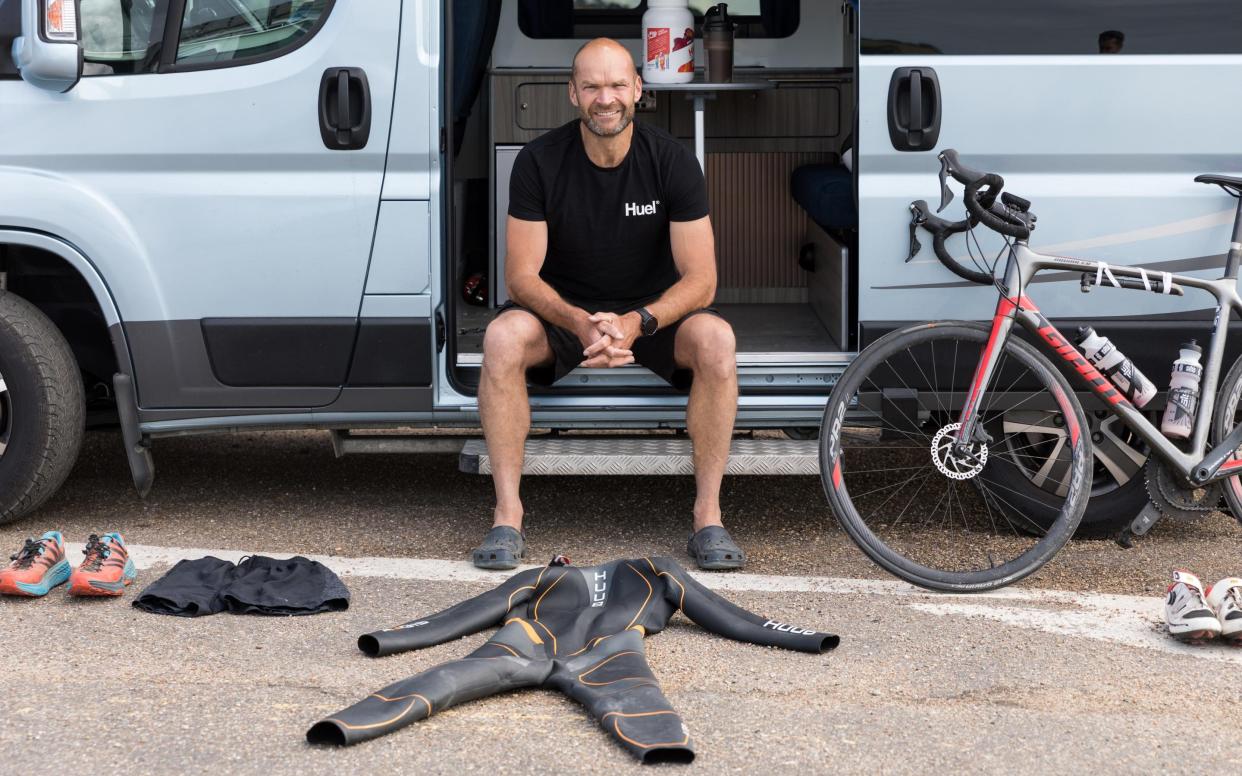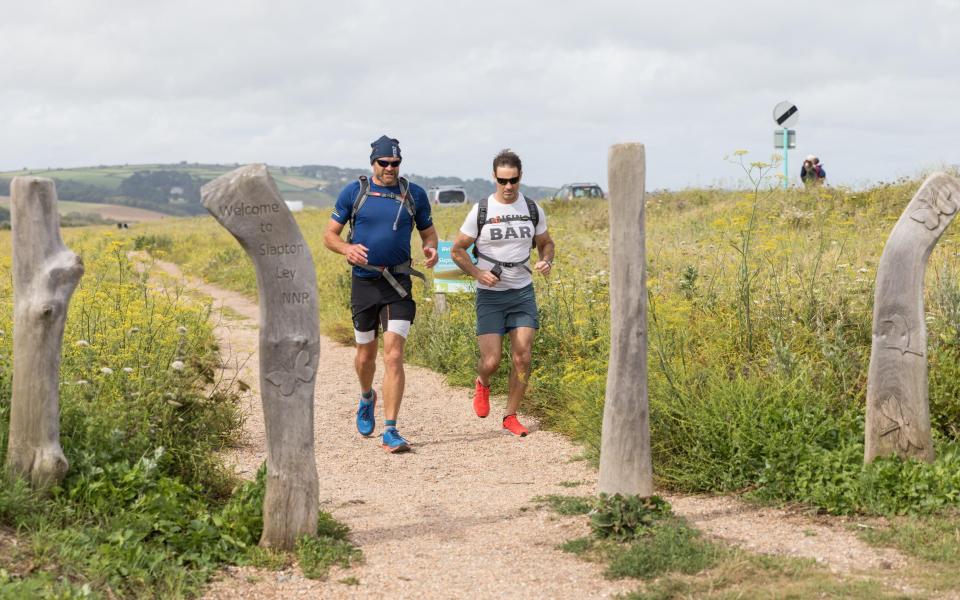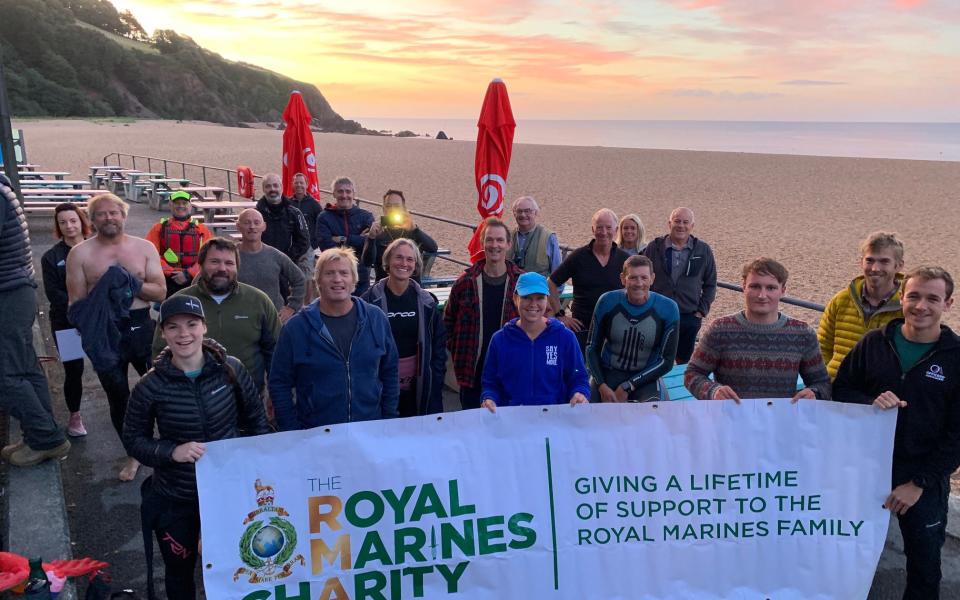This gruelling Ironman showed me the endless scope of human spirit

One word that seems to be perennially associated with Devon is “gentle”.
Our memories of it frequently stem from the bucolic holidays of our youth – all those quiet coves and green fields, with cream teas to the fore. Devon has 125 miles of coast, which this year saw a surge of visitors as the first lockdown eased. I’m aware of this, as I came as a visitor in the 1990s and never really left. My travels have taken me to many places since, but part of me has a quiet yearning for ambles along the coast path and – latterly – shrieking explorations of rock pools with my kids.
But, as I stood on this particular Devon beach one morning, in that halcyon period between Lockdown 1 and Lockdown 2, I was about to recalibrate my amiable relationship with the place I now called home. I adjusted my goggles, rolled my neck from side to side, and gave an explosive exhalation of breath. All around was a general feeling of bonhomie, warmth, and mutual support. The sound of muted laughter cut through the clear morning air.
The dawn was exquisite, with the sea as flat as treacle, and tiny wavelets flopping gently on the shingle to create ringing metallic notes as the pebbles rolled and tumbled beneath. The headland glowed in the morning sun, gilded and crystal clear against the backdrop of the immense sweep of Start Bay.
On any other morning, on any other day, this would have been a moment to savour. I would have paused, taken a deep breath, and perhaps sat down for a while to watch the sun rise fully. But at this moment, on this day, my senses were heightened for different reasons. Ahead of me lay a glowering monster, an uncompromising beast that would never let up and would reach the dark places in my soul. What’s more, in a neatly ironic twist, it was a beast of my own creation. Through the spring and summer of this year, lockdown hit us all. For many the impact was truly cataclysmic, with the loss of loved ones, livelihoods ruined, communities and individuals challenged to their core.
For others – rendered more fortunate simply by serendipity, age or location – the impact was less intense but still seismic. For me – a middle-aged man used to a life on the road – it meant enforced proximity to my family (a pleasure for me, possibly slightly unnerving for them) and a chance to engage with my surroundings. Not a day passed without me blessing this stroke of good fortune, but wondrous though a walk through the woods or along the coast path was, a certain restlessness soon emerged. This stemmed from my curtailed nomadic lifestyle, combined with a nascent midlife crisis and an urge to use precious time to the best of my abilities. But even then, everything needs a trigger, and mine was about to be pulled.

I had long wanted to attempt an Ironman – the ultimate test of endurance and mettle for anyone who wants to go that extra mile – but the pandemic had put paid to any plans to do so. As I sat at a beachside café as lockdown was easing, the solution abruptly presented itself. For an Iron distance event you need something damp to swim in, something hard to cycle on, and something meandering to run along. A glance to the left revealed the sea, a glance to the right a narrow country road, and a glance behind the coast path.
A final glance opposite – at my coffee-drinking companion, who happened to be an Iron distance coach – solidified things. We’d arrange it ourselves. Iron distance racing has gone global. From a mere 15 competitors who stood nervously on the line in Hawaii in 1978 for the first Ironman, there are now more than half a million competitors across the world, registering in the 170 official Ironman races as well as scores of unofficial events. The concept is simple – swim 2.4 miles, jump on a bike and cycle 112 miles, then leap nimbly off to run a spring-heeled marathon. Well, that’s what you do if you’re one of the one per cent of professional athletes taking part.
The remaining 99 per cent splash, wheeze, and stagger their way round as best they can. I fitted into this category.
The first thing we needed to do was figure out a course. Happily the distance between our two favourite sea swimming spots was 2.4 miles. One lap of our bike route was 28 miles (so four would be required), and – would you believe it – out and back along the coast path from Dartmouth to Prawle Point (the southernmost headland in Devon) was 26 miles. Our route was sorted.
Of course it would be hard, of course it would push me to my limits, but there would be the ample compensation of moving through one of the most beautiful landscapes on earth. Ah, the steepling cliffs, the ancient narrow lanes, the serried ranks of emerald fields running down to an azure sea. Or, put it another way: ah, those relentless, savage, unyielding, energy-sapping hills. Imagine running along a colossal Toblerone laid on its side – that was our course. In terms of altitude gain overall, it would be the equivalent of cycling and running up Ben Nevis three times in a row within 17 hours, including the time it would take to swim 2.4 miles through the sea to get there. It turned out we had just created one of the top 10 hardest Iron distance events on earth.

I set about training. Puce of face and tense of calf, I rose at dawn and fell asleep at dusk, with much of the interim period taken up with cycling, sea swimming, and running along the twisting length of the marathon course. There is a vast amount of material out there about training for an Iron event – as with childbirth, everyone has an opinion, but personally all you are aware of is an unavoidable date bearing down on you (a reference made by my wife; Iron distance preparation is a family affair).
Suffice to say it requires long – very long – periods of moderate discomfort, after which you climb into bed with all the grace of a dynamited lighthouse. Then you get up and do it all over again.
Inspiration came from the people for whom we raised money: Royal Marines veterans who had their lives utterly transformed in a moment of heat and dust on a far-flung shore. Weariness on a long run paled into insignificance next to their quiet fortitude and grace. And so the great day dawned. By now word had got out, and as I stood to give the race briefing, I was looking at an eclectic group of eccentrics and ultra-runners, as well as a global sporting icon, a world record ocean rower, and an Everest mountaineer. The race is open to all in 2021 but, for this first year, here was a rather splendid group of athletes. The next 18 hours or so showed that the human spirit can shine bright under any circumstances, in any year.
All eight athletes completed the course, with the winner – a young Royal Marine called Will Tyrrell-Moore – completing the event in just 11 hours and 32 minutes, five hours ahead of the next competitor. For the rest of us, the memories are of the bellowed support of the volunteers who turned up to help in any way they could, and the warm words of fellow competitors as the night drew in after the longest of days with many a mile still to cover.
Here was the affirmation that even in the darkest of times, there is something tectonic and irresistible about a group of people getting together and deciding to make something happen. It was all the sweeter that every laboured swim stroke, every weary turn of the pedals, and every shuffled step raised money to support others.
In an age where the normal reference points have shifted and where uncertainty reigns supreme, there has never been a better time to set a goal, to find an outrageous challenge and make it your own. There has also never been a more suitable moment – for both mental and physical health – to don the woolly hat and hit the meandering paths. There is real magic in watching your breath fog in the cold light of dawn, in connecting to the world around you, and slowly feeling your body transformed.
The Royal Marines Iron Challenge becomes an open event next year, although the focus remains firmly to raise money for our veterans. To register go to the website at iron2steel.co.uk
The Five Toughest Ultra Distance Races
As voted for by 220 Triathlon magazine (220triathlon.com)
Triathlon X Extreme, held in the Lake District. In 2019, 101 people registered, only 15 turned up, and only one of them finished. So quite tough then. An absurd festival of relentless hills and flatulent gurning.
Evergreen 228, held in Chamonix, France. 7,600m of ascent, with 41 per cent of the competitors not finishing.
Blacklake. This event of positively biblical toil takes place in Montenegro, and involves a swim in a jet-black lake, followed by 5,800m of altitude gain in the bike and run. Half of the competitors who entered didn’t make it to the end in 2019, with the other half delighted that lockdown stopped them doing it this year.
Celtman Extreme, where a quick dip in a Scottish loch starts your day. You bat aside the jellyfish to leave the water eventually and begin a bike and run with 3,410m of elevation gain.
Altriman, in the French Pyrenees, where flat bits of terrain are in tragically short supply. This race is defined by a ludicrous 5,000m altitude gain on the bike section. To finish, one must have thighs like Parma hams, and a relaxed attitude to excruciating discomfort.


